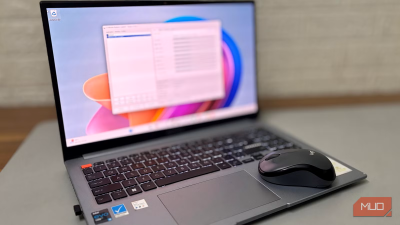
Windows 11 doesn't throw ads in your face the way websites do, but it still slips in promotions across the system. The Start menu can suggest apps you never searched for, the Settings app shows recommended content, and File Explorer occasionally displays a OneDrive banner. I ignored most of it for a long time because it blended in so well that it didn't feel like something I could turn off.
Over time, though, I started noticing how often those prompts appeared and got curious about how much of it was built in. I opened the settings just to check, expecting most of it to be hardwired into the system. Instead, I found that most of the ads and suggestions were controlled by simple toggles. I disabled them one by one and was surprised it took only a handful of changes to clear out almost all of it.
Turn off Start menu suggestionsRemove unwanted app recommendations from Start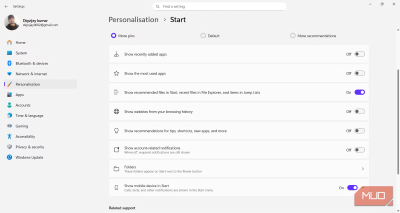
The first place I checked was the Start menu because subtle promotions can appear there. It shows your own shortcuts alongside a Recommended area, which can include Microsoft suggestions that aren't based on what you use. Over time, these suggestions make the menu feel cluttered instead of personal.
To remove them, open
Settings -> Personalization -> Start, then turn off the following options:
1. Show recommendations for tips, shortcuts, new apps, and more.
2. Show websites from your browsing history.
3. Show account-related notifications.
Once these were disabled, the Start menu stopped surfacing suggested apps and promotions, and my pinned apps stayed front and center.
Disable File Explorer adsStop OneDrive and Microsoft 365 banners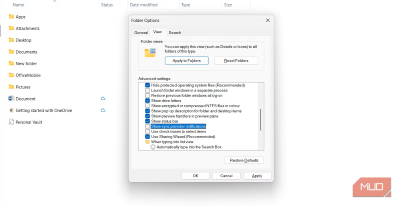
The next place I checked was File Explorer, since even the file manager occasionally promotes Microsoft services. Sometimes, a thin banner appears at the top suggesting OneDrive backups or Microsoft 365 subscriptions. These banners are not system messages. They are ads shown through what Windows calls "sync provider notifications."
To disable them:
1. Open File Explorer.
2. Select the
three dots (⋯) in the toolbar and choose
Options.
3. In the
View tab, scroll to
Show sync provider notifications.
4. Uncheck it, then click
Apply and
OK.
After turning it off, File Explorer stopped showing OneDrive prompts, and the interface stayed focused on local files and folders.
Remove lock screen promotionsKeep Spotlight from showing tips or ads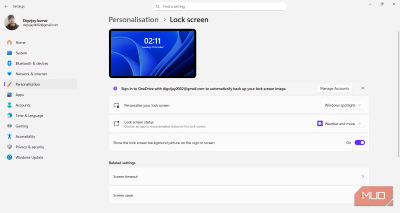
The lock screen also includes its own form of promotion. With Windows Spotlight enabled, it displays rotating backgrounds along with tips and suggestions, sometimes including prompts related to Microsoft services such as Edge or OneDrive. Switching to a static picture removes those Spotlight messages.
To turn those off:
1. Navigate to
Settings -> Personalization -> Lock screen.
2. Change the background from
Windows Spotlight to
Picture or
Slideshow.
Once Spotlight is disabled, the lock screen becomes simple and static, showing only the image you choose without Spotlight suggestions.
Turn off recommendations and offers in SettingsHide promotional banners inside Settings pages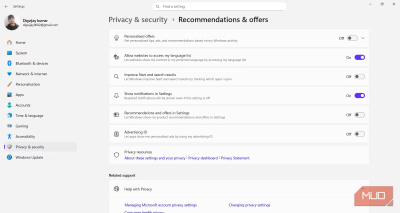
After disabling Spotlight, I opened the Settings app itself, since it occasionally shows promotions at the top of certain pages. These can include banners suggesting Microsoft 365 trials, OneDrive sign-ins, or extra features that are not essential.
To turn these off, open
Settings -> Privacy & security -> Recommendations & offers, then toggle off the following:
1. Personalized offers.
2. Improve Start and search results.
3. Recommendations and offers in Settings.
4. Advertising ID.
Leave other switches such as
Allow websites to access my language list and
Show notifications in Settings enabled, since they are not related to ads.
Disable pop-up tips and notification promptsStop setup and feature suggestion alerts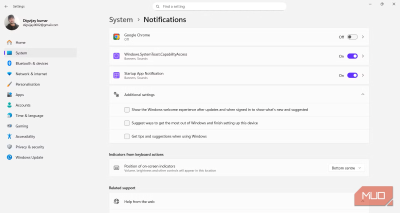
Windows also sends promotional tips through its notification system. They appear as small banners suggesting actions such as finishing setup or signing in with a Microsoft account, and can be turned off from the Additional settings section on the same page.
To stop them, navigate to
Settings -> System -> Notifications, then scroll to
Additional settings at the bottom of the page, and turn off the following:
1. Show the Windows welcome experience after updates, and when signed in, show what’s new and suggested.
2. Suggest ways to get the most out of Windows and finish setting up this device.
3. Get tips and suggestions when using Windows.
After disabling these, notifications focus on actual app alerts instead of product promotions and system nudges.
Remove widgets and taskbar adsClear sponsored cards and trending content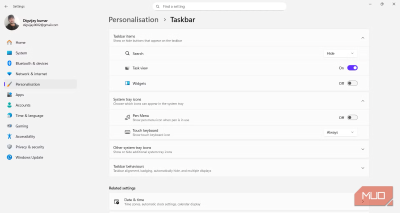
The last area I checked was the taskbar, where Windows shows Widgets and Search content that can include promotions or trending items. The news feed inside Widgets can surface sponsored cards and app recommendations. You can turn these off with a couple of settings to keep the desktop cleaner.
To disable them, go to
Settings -> Personalization -> Taskbar, then look under Taskbar items and make these changes:
1. Toggle off
Widgets.
2. Open
Search and set it to
Hidden or
Search icon only to reduce suggestions on the taskbar.
Once these were off, the taskbar stopped showing news cards or trending prompts, and the desktop looked cleaner and more focused.
A quieter version of Windows 11These are some tweaks that finally stopped the extra noise in Windows 11. Each one disables a small part of the system that promotes Microsoft's own services, whether through suggestions, banners, or pop-ups. After turning them off, Windows looks cleaner and focuses more on what you open rather than what it recommends.
In some cases, these suggestions may reappear after major Windows updates, when certain settings are reset to their default. If that happens, revisit the menu you changed earlier and check that the toggles are still off. It's also worth doing this on a new PC or fresh installation, since most of these options are already enabled.
source